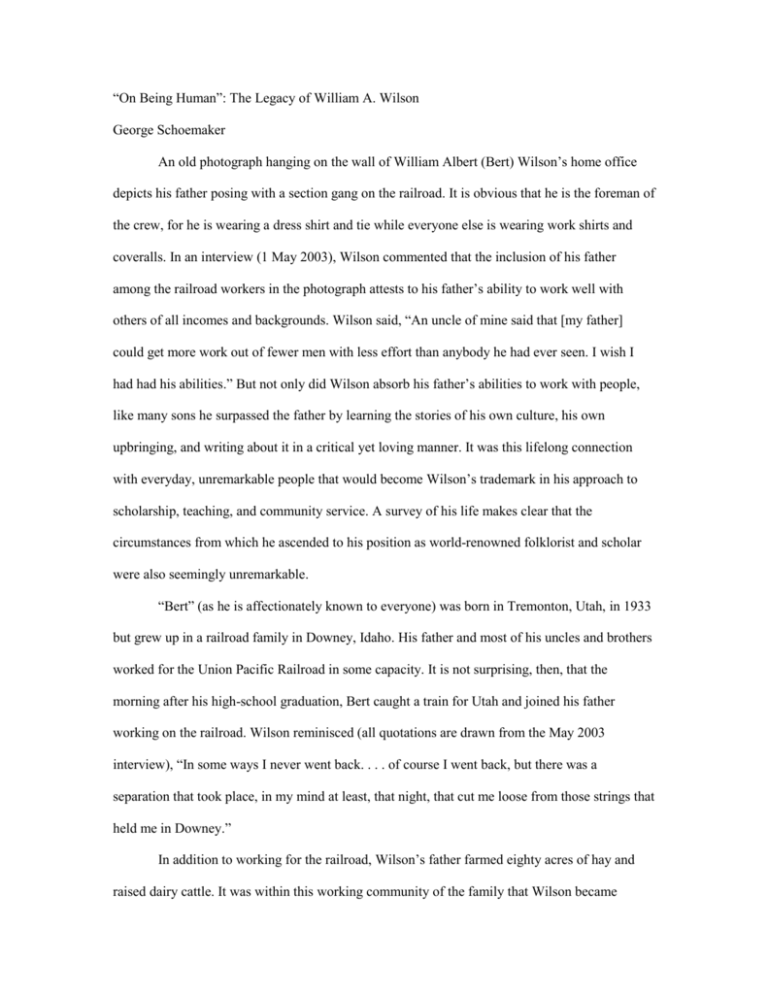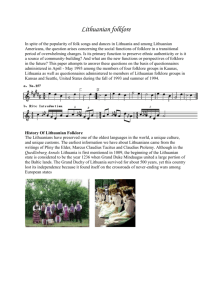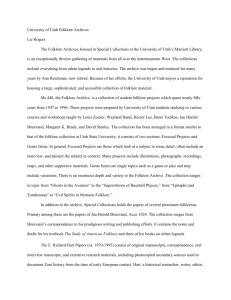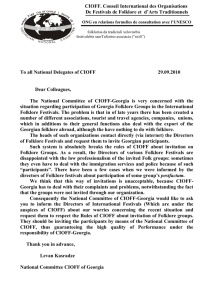Bert Wilson Chapter - Westminster College
advertisement

“On Being Human”: The Legacy of William A. Wilson George Schoemaker An old photograph hanging on the wall of William Albert (Bert) Wilson’s home office depicts his father posing with a section gang on the railroad. It is obvious that he is the foreman of the crew, for he is wearing a dress shirt and tie while everyone else is wearing work shirts and coveralls. In an interview (1 May 2003), Wilson commented that the inclusion of his father among the railroad workers in the photograph attests to his father’s ability to work well with others of all incomes and backgrounds. Wilson said, “An uncle of mine said that [my father] could get more work out of fewer men with less effort than anybody he had ever seen. I wish I had had his abilities.” But not only did Wilson absorb his father’s abilities to work with people, like many sons he surpassed the father by learning the stories of his own culture, his own upbringing, and writing about it in a critical yet loving manner. It was this lifelong connection with everyday, unremarkable people that would become Wilson’s trademark in his approach to scholarship, teaching, and community service. A survey of his life makes clear that the circumstances from which he ascended to his position as world-renowned folklorist and scholar were also seemingly unremarkable. “Bert” (as he is affectionately known to everyone) was born in Tremonton, Utah, in 1933 but grew up in a railroad family in Downey, Idaho. His father and most of his uncles and brothers worked for the Union Pacific Railroad in some capacity. It is not surprising, then, that the morning after his high-school graduation, Bert caught a train for Utah and joined his father working on the railroad. Wilson reminisced (all quotations are drawn from the May 2003 interview), “In some ways I never went back. . . . of course I went back, but there was a separation that took place, in my mind at least, that night, that cut me loose from those strings that held me in Downey.” In addition to working for the railroad, Wilson’s father farmed eighty acres of hay and raised dairy cattle. It was within this working community of the family that Wilson became immersed in the world of storytelling: “. . . my dad wasn’t a storyteller, but my mother’s brothers were, so at dinnertime during Thanksgiving and other celebrations, when we’d all gather there, they would engage in these storytelling events, . . . each one presenting himself as the most heroic person that ever worked for the railroad.” Wilson also values the more private stories told by his mother about her life growing up on an Idaho homestead, even though at the time he didn’t think of them as anything special--except that he always enjoyed them and liked to hear them. In 1953, after completing a couple of years of college at Brigham Young University (BYU) in Provo, Utah, Wilson traveled to Finland as a missionary for The Church of Jesus Christ of Latter-day Saints (the Mormon Church). He felt very much at home in Finland and came to admire the Finns and their language and culture. He also became aware of the importance of the Finnish national epic, The Kalevala, and learned enough about it that he determined to study it seriously upon his return to the university. Wilson had decided to major in English; his goal was to obtain a teaching certificate and eventually teach high school, but once he completed his bachelor’s degree, he decided to go on and obtain a master’s from BYU while teaching English at Bountiful High School to support his wife, a young Finnish woman named Hannele Blomqvist whom he had met while serving his mission. At the time, BYU was experiencing rapid growth and was in serious need of new professors to keep up with the school’s expansion. Consequently, when Wilson was meeting with the chair of his thesis committee, he was offered a teaching job as a special instructor at BYU. Once he finished his master’s degree in 1962, his colleague Robert Blair, a professor of linguistics and a former missionary in Finland, encouraged Wilson to go to Indiana University (IU) because it had a first-rate Uralic Studies and Folklore Program. Wilson wasn’t particularly enthusiastic about studying folklore, but he thought that it would help him better understand The Kalevala and Finnish literature, and that IU would provide him with the best programs in both disciplines. Having received a National Defense Language Fellowship to study Finnish and Estonian, Wilson began his studies at IU, where he became interested in Johann Gottfried Herder (17441803), a German scholar of folklore and literature who developed the Romantic notion that the soul of a nation or people could be discovered through their folk traditions. In 1965-66, Wilson spent sixteen months in the library of the Finnish Literature Society on a grant from the Fulbright Commission and brought back to Indiana volumes of notes and other materials on the cultural history of Finland. With an outline of all his Finnish materials, he went to consult with the director of Indiana’s Folklore Institute, Richard M. Dorson, about possible topics for a Ph.D. dissertation. Dorson looked at the outline and told Wilson that he had a lifetime’s worth of topics for possible research, but he looked at one particular point and said, “There’s your thesis, right there.” What Dorson had pointed out was the interplay between scholarship and nationalism in Finland and how each influenced the other in the nineteenth and twentieth centuries. This kernel of encouragement eventually led to Wilson’s dissertation, later published by Indiana University Press under the title Folklore and Nationalism in Modern Finland (1976). It took Wilson longer than he expected to complete the dissertation. He had resumed teaching a full load of courses for the English Department at BYU in 1967 but then developed thyroid cancer and underwent five surgical procedures in a span of two years to combat the disease. Finally, in 1973, he took a leave of absence from BYU so that he could go back to IU to complete his dissertation. During his first stay in Bloomington, he had become well acquainted with Dorson, who said he was pleased that “a Mormon” was coming to the Folklore Institute to study. Dorson had already published his survey, American Folklore, and was then working on Buying the Wind, a study of American regional folklore; both books had important sections on Mormon folklore. Wilson explained: The irony was that I had never thought at all, at that point in my life, of having any folklore myself. I had the notion that folklore belonged to everybody else and I had all the wrong notions that people have about folklore. But that one conversation got me thinking and I picked up and read [Austin and Alta] Fifes’ Saints of Sage and Saddle and wrote a review for it in one of his [Dorson’s] classes. He liked it a lot, and that got me looking at my own culture. And I did the fieldwork project at IU that we all had to do, collecting [Three] Nephite stories from fellow Mormon students and from faculty members there. Dorson was amazed that I could collect Mormon folklore outside of Utah, because he still had the idea that Utah was a culturally isolated enclave. Wilson’s academic interests, then, were two-pronged from the beginning of his career at IU. On the international level, he was researching Finnish literature and culture with a special emphasis on folklore and The Kalevala; in the United States, he began to focus on Mormon folklore studies and other subjects related to the American West, an interest that developed further when he spent the summer of 1978 participating in a project supported by the American Folklife Center in the Library of Congress to document ranching culture in Paradise Valley, Nevada. Beginning in 1969, when he published his first article, “Mormon Legends of the Three Nephites Collected at Indiana University,” Wilson gained an international reputation for his studies of Mormon folklore and for his insistence that individuals can do some of their best work within their own cultures. His work has opened doors to the intricacies of Mormon culture, particularly with his dozens of articles on the folklore of Mormon missionaries, on Mormon humor, on religious narratives and legends, on the portrayal of minority groups in Mormon folklore, and on the importance of folklore in its interaction with the religious, social, and historical dimensions of Mormonism. Other important work, published primarily in the 1990s, has focused on family folklore and storytelling, relying on the narrative traditions of his family and his Idaho upbringing. Perhaps most noteworthy about his research has been his consistent focus on the multidimensional role that folklore plays in human societies. He has shown, for example, that the lore of Mormon missionaries simultaneously supports behavioral codes and the Mormon hierarchy of authority, yet it also provides the missionaries the opportunity to imagine the possibility of rebelling against those very strictures. Other articles have shown the utility of folklore collection and research for historians and literary scholars, and several major articles have placed folklore firmly within the humanities disciplines as a worthy companion to history, philosophy, and literature. His numerous articles on Mormon folklore have emphasized the universality of folk expression and tradition within religiously based folk groups, at the same time reminding his readers of the role of folklore in defining and maintaining a group’s system of beliefs and values. Wilson was also instrumental in furthering folkloristics in Utah through the development of university folklore programs and archives and through his support of the Folklore Society of Utah (FSU). While FSU had a long history in Utah, dating back to 1958 (see chapter 25), the society in the early 1970s had entered a period of relative inactivity, and Wilson—who had just been elected the society’s president--wanted to see it become more vigorous by cultivating interest in Utah folklore among academicians, students, and regular Utahns. During Wilson’s tenure as president, Austin Fife suggested dissolving FSU and turning over all its records, fieldwork, documentation, and notes to either the State Historical Society or the University of Utah Library’s Special Collections. Wilson demurred. He felt that Utah needed FSU, so he worked out a collaboration with Charles Peterson, then director of the State Historical Society—an arrangement that continued with Peterson’s successor, Melvin T. Smith--to hold FSU meetings in conjunction with the annual meetings of the State Historical Society. This move helped to save FSU and brought new life to the society. Participants in the folklore section of the meeting were mostly Wilson’s students; occasionally, faculty also presented papers. According to Wilson, the partnership with the State Historical Society helped to lend an air of legitimacy to the burgeoning folklore studies programs in Utah, especially since the state lacked a folklore journal of its own. In addition to his work with FSU, Wilson also traveled throughout the state on a kind of personal crusade for folklore studies, giving lectures for the Humanities Council or the Historical Society on the subject of local culture to “anyone who would listen. . . . Sometimes I’d have a good audience, sometimes I’d have three or four people, but I talked with anyone who would listen about folklore.” Many of his numerous articles since that time have been published in history as well as folklore journals. His tireless efforts over a thirty-year period to build bridges between folklore and history and to reveal their mutual interests culminated in his receiving two major awards in 2002: the Leonard J. Arrington Award from the Mormon History Association for “a distinctive contribution to the cause of Mormon History,” and the Américo Paredes Award from the American Folklore Society “for outstanding community engagement and for encouraging students and colleagues to work within their home communities.” Another important step in the development of folklore studies in Utah came with the appointment of Utah’s first state folklorist in 1976. At the time, Barre Toelken, then of the University of Oregon, was a member of the Folk Arts Panel for the National Endowment for the Arts (NEA), and he flew to Salt Lake City to talk about the position with Wilson, Jan Harold Brunvand, and Hal Cannon. While the development of a Folk Arts Program within the Utah Arts Council, the state arts agency, seemed broadly supported in Utah because of what seemed to be an attractive combination of scholarship and public outreach, there was, in Wilson’s words, mild opposition about “muddying the waters between the academy and the public sector.” Nevertheless, the position was authorized with initial funding from the Endowment, Cannon was appointed to the position, and Wilson went on to serve for eight years on the Board of the Utah Arts Council, where he also chaired the Folk Arts Panel. In the early 1980s, Wilson was appointed to the NEA Folk Arts Panel, where he served for four years. During this period, Cannon submitted an application requesting financial support for the first Cowboy Poetry Gathering, to be held in Elko, Nevada, in January 1985. At the time, there was a perception among some folklorists in the East that such a festival was not in keeping with the goals of the NEA Folk Arts section. Wilson lobbied hard to get the grant approved and funded by the panel; twenty years later, what is now the National Cowboy Poetry Gathering is financially self-supporting and has become the most important national festival for cowboy performance arts. After eleven years teaching folklore in the English Department at BYU, Wilson accepted an offer from Utah State University in 1978 to direct, develop, and expand a folklore program offering both undergraduate and graduate courses to be cross-listed in both English and history. He expanded the undergraduate curriculum and laid the foundation for the development of a master’s degree program in American Studies with a folklore emphasis. At the same time, Wilson began directing the Fife Folklore Conference, which met every summer at Utah State University beginning in 1977. The first conference had been held the year before he arrived at USU, and its popularity continued to grow after his arrival; it is now considered one of the premier folklore conferences in the United States (see chapter 25). Soon after the conference’s inception, Wilson, Cannon, and Carol Edison began encouraging publicsector folklorists from the western states to hold their own meetings in conjunction with the conference, a setting that provided valuable interplay between public-sector and academic folklorists. Wilson continued to direct the conference, with Barbara Walker (Lloyd) as codirector, until 1984, when he returned to BYU as professor of folklore and Scandinavian Studies and chair of the English Department. From the time that he taught his first folklore course at BYU, Wilson had been amassing term projects and items of folklore gathered by his students. Eventually he sought space, first at BYU, later at USU, to house what had become an important collection of Utah folklore. Wilson’s model for organizing and systematizing these archives derived from Jan Harold Brunvand’s generic classification system in The Study of American Folklore. Wilson elaborated on Brunvand’s typology and created a system that is infinitely expandable; it is still used at BYU, USU, and other institutions, and a modified version is in use at the archives of the Utah Arts Council’s Folk Arts Program. The undergraduate and graduate programs at USU and the Fife Conference developed further during the years that Wilson was at the helm, but those years were fruitful in other ways as well. From 1979 to 1983, he edited Western Folklore, one of the flagship journals of folklore scholarship in the United States. Wilson jokes, “The dean was very supportive [of having Western Folklore edited at USU] because . . . we had Western American Literature, the Western Historical Quarterly, and now to have Western Folklore, it was the Holy Trinity at Utah State!” Wilson approached the editing of Western Folklore with the goal that most of the articles accepted for publication in the journal ought to be ones that could be assigned in college folklore courses and which the average college student could understand. This down-to-earth approach to editing the journal was really an extension of Wilson’s approach to everything he has done in his life. As he has said, if he couldn’t create and build and make connections to other disciplines, fields, and levels of society, then the activity wasn’t worth pursuing. His stories of his grandmother, his mother, and his railroading family are all infused with the heroism of everyday people. He said: I wanted my children to know their grandmother’s stories, because they were crucially valuable to me . . . through my work in folklore, and I had come now to understand--especially when folklore began moving not just to third-hand stories but to personal narrative--I began to see the value in what nobody ever told me was valuable when I was young. Those stories of my uncles and my mother shaped my life, gave me a worldview, gave me a sympathy for common, ordinary people that I think I still have, and that nobody ever valued in my education through my master’s degree. . . . When I went to Finland and saw, good grief, how the creative efforts of the common, ordinary people there had been used to build an entire nation and create a national identity in a country that was fragmented and had no unity, I began to really find the field I should have been in all along. The impact of Wilson’s contributions to the development of folkloristics in Utah is still being felt. He has been a tireless crusader in making people in Utah see folklore as a legitimate discipline and field of study, not only in the academy but also in his presentations and discussions with ordinary people. In doing so, Wilson has helped the people of Utah become aware of their living state treasures, the numerous folk artists and performers living in their own backyards. His invitation to deliver BYU’s Distinguished Faculty Lecture and his appointment as Humanities Professor of Folklore and Literature, both in 1990, are evidence of his success in helping to establish folklore as a legitimate area of study within the state in addition to the national and international recognition of his scholarship. He has been a program builder at both BYU and USU, with the consistent goal of creating programs that would outlast him. Testament to his success is the fact that by the year 2000, each school had three full-time folklorists--plus some part-timers--teaching, advising students, building the archives, doing research, and writing for publication. The archives that Wilson established, now part of special collections at their respective university libraries, and the Fife Folklore Conference continue as major resources for research and learning. The importance of Wilson’s scholarship and leadership in the development of Mormon folklore studies in the United States, and his contributions to European and Finnish Studies both in the United States and Finland, have been recognized with over thirty fellowships and honors, including the Arrington Award; the Paredes Prize; the Charles Redd Award from the Utah Academy of Sciences, Arts, and Letters; the Aimo Turunen Medal from the Kalevala Society of Finland; and the Utah Governor’s Award in the Arts. In 2003, the folklore archive at BYU was renamed the William A. Wilson Folklore Archive. Despite these honors, despite his eighty-seven publications and hundreds of public lectures and presentations, he says that he still thinks that his most significant contribution is in his efforts to recognize the fundamental worth of the individual: “I believe in the worth of every human being, not just in the elite, not just in the well- educated, but every living person is as worthwhile as any other living person--and folklore brought me into that.”






